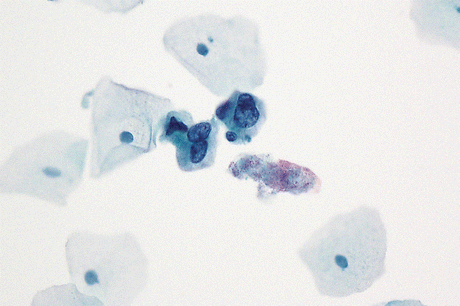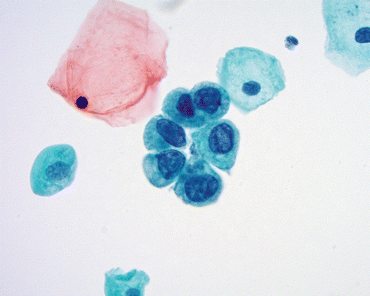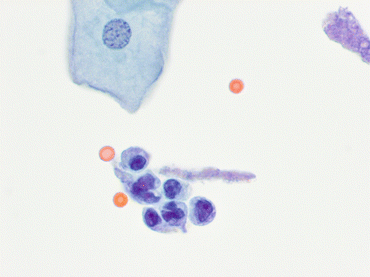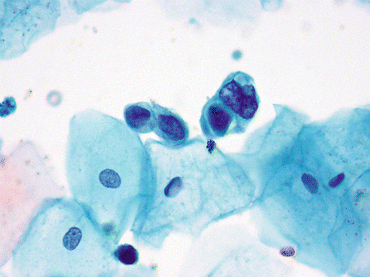Fig. 5.1
Suspicious for high-grade urothelial carcinoma (SHGUC). One single abnormal well-preserved intermediate urothelial cell displays an eccentric nucleus with increased N/C ratio, hyperchromasia, irregular clumpy chromatin, and mildly irregular nuclear membrane (Voided urine, TP, high mag.)

Fig. 5.2
Suspicious for high-grade urothelial carcinoma (SHGUC). Rare but abnormal well-preserved intermediate urothelial cells showing increased N/C ratios, hyperchromasia, and irregular nuclear membranes (Catheterized urine, CS, high mag.)

Fig. 5.3
Suspicious for high-grade urothelial carcinoma (SHGUC). A few abnormal intermediate urothelial cells, one of which is well preserved (center) and features an increased N/C ratio, hyperchromasia, irregular clumpy chromatin, and severely irregular nuclear membrane. If more than five similar cells were found, the diagnosis of HGUC would be appropriate (Catheterized urine, CS, high mag.)

Fig. 5.4
Suspicious for high-grade urothelial carcinoma (SHGUC). A cell cluster composed of six abnormal well-preserved intermediate urothelial cells showing increased N/C ratios, hyperchromasia, clumpy chromatin, and irregular nuclear membranes. Note that not all the cells have an N/C ratio that exceeds 0.7 but in the presence of similar nuclear characteristics, they should be considered part of the same lesion. A “positive for HGUC” diagnosis may be acceptable in this case, especially in the presence of a previous history of HGUC (Catheterized urine, CS, high mag.)

Fig. 5.5
Suspicious for high-grade urothelial carcinoma (SHGUC). A cell cluster composed of four abnormal well-preserved intermediate urothelial cells having increased N/C ratios, hyperchromasia, and irregular nuclear membranes in the absence of clear chromatin details. Note that the N/C ratios vary significantly within the group with only two cells having an N/C ratio exceeding 0.7 (Voided urine, TP, high mag.)

Fig. 5.6
Suspicious for high-grade urothelial carcinoma (SHGUC). A few abnormal well-preserved intermediate urothelial cells display increased N/C ratios, hyperchromasia, prominent nucleoli, and irregular nuclear membranes in the absence of evaluable chromatin details (Catheterized urine, CS, high mag.)

Fig. 5.7
Suspicious for high-grade urothelial carcinoma (SHGUC). One single abnormal well-preserved intermediate urothelial cell showing increased N/C ratio, hyperchromasia, irregular clumpy chromatin, and smooth regular nuclear membranes. Note the severe hyperchromasia in comparison to the normal intermediate urothelial cells (right) (Catheterized urine, CS, high mag.)

Fig. 5.8
Suspicious for high-grade urothelial carcinoma (SHGUC). Rare but abnormal well-preserved intermediate urothelial cells having increased N/C ratios, hyperchromasia, clumpy chromatin, and irregular nuclear membranes. Note that although the nuclear size is not significantly larger than normal intermediate cell nuclei, the cells contain cytological nuclear abnormalities that warrant a “suspicious for high-grade urothelial carcinoma” diagnosis (Voided urine, SP, high mag.)

Fig. 5.9
Suspicious for high-grade urothelial carcinoma (SHGUC). Rare but abnormal well-preserved intermediate urothelial cells showing increased N/C ratios, hyperchromasia, irregular nuclear membranes but overall fine evenly distributed chromatin (Voided urine, TP, medium mag.)
Increased nuclear to cytoplasmic (N/C) ratio, at least 0.5–0.7 “Required diagnostic criterion”
Moderate to severe hyperchromasia “Required diagnostic criterion”
In addition, at least one of the two following features needs to be present:
Irregular clumpy chromatin
Marked irregular nuclear membranes
Using all the features listed above, the decision to assign the case into the “SHGUC” or the “positive for HGUC” categories is based on the number of the abnormal cells fulfilling the above criteria. Depending on individual cases assigned to the “suspicious” category, the number of abnormal cells can range from as low as one to as high as ten cells. Due to the lack of definitive data derived from studies specifically addressing this quantitative issue, a strict cut-off number of abnormal cells above which one can confidently assign a “positive for HGUC” diagnosis cannot be definitely implemented at the current time. Instead, a cut-off range of 5–10 cells is recommended based on the degree of abnormal nuclear changes observed, and the level of pathologist’s comfort. Accordingly, a “positive for HGUC” diagnosis should very rarely, if ever, be assigned in the presence of less than five abnormal well-preserved cells. In comparison, in the presence of 5–10 abnormal cells, the decision to assign a “positive for HGUC” diagnosis should take into account the severity of atypia of all the abnormal cells, the clinical context as well as the specimen type. As an example, in the presence of a previous history of HGUC and/or in voided specimens which are by nature less cellular than instrumented specimens and in which cellular degeneration is frequent, as low as five well-preserved and severely abnormal cells with the features listed above may be sufficient to render a definitive “positive for HGUC” diagnosis. On the other hand, it is recommended to have at least ten abnormal cells before labelling a case as “positive for HGUC” in instrumented specimens derived from the upper urothelial tract (see Chap. 6, for further discussion).
The cells are usually seen as single cells although clusters of atypical cells may also be present. The above diagnostic criteria are most reliably assessed in the single cells.
Nuclear size is usually at least twice the size of the normal intermediate or deep cell’s nucleus although this feature is not mandatory.
Features that may be seen but do not necessarily need to be present are:
Eccentric nuclear location (see Fig. 5.1).
Necrotic background.
Pleomorphism.
Mitoses.
Stay updated, free articles. Join our Telegram channel

Full access? Get Clinical Tree


